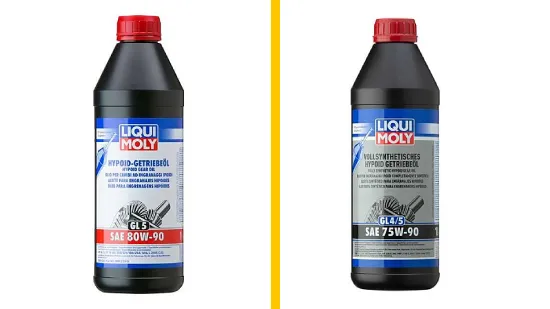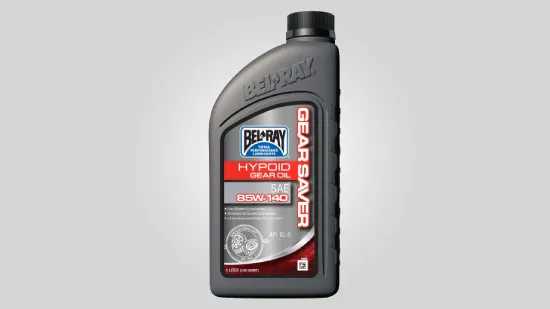Physical Address
304 North Cardinal St.
Dorchester Center, MA 02124
Physical Address
304 North Cardinal St.
Dorchester Center, MA 02124

The choice of gear oil plays a pivotal role in ensuring the smooth operation and longevity of a vehicle’s mechanical components. Within the realm of vehicle lubrication, two prominent contenders emerge: hypoid gear oil and synthetic gear oil.
Hypoid gear oil is purpose-built for hypoid gear sets with unique hyperbolic geometry. In contrast, synthetic gear oil offers versatility, catering to a broader range of vehicle engine types and operating conditions.
Although specialized lubricants offer distinct advantages, they differ significantly in composition, application, performance, and overall impact on the vehicle.
Here, we’ll explore the differences between hypoid and synthetic gear oil. Wondering if hypoid oil is synthetic and what the longevity of synthetic gear oil is. You will also know if changing gear oil can boost your mileage.
No products found.

When considering the differences between hypoid and synthetic gear oil used in vehicles, there are several key points to examine.
Let’s dive into each of these points to see how hypoid and synthetic gear oil differ.
To understand the differences between hypoid and synthetic gear oil for vehicles consider their composition and application.
Hypoid gear oil is specifically designed for hypoid gear sets with unique hyperbolic geometry and non-intersecting, non-parallel axes. It’s primarily used in rear axle differentials to transfer power from the driveline to the axle shafts.
On the other hand, synthetic gear oil is used when mineral gear oils no longer meet performance requirements. Especially in extreme conditions like low or high temperatures, high loads, or unique ambient conditions.
Synthetic gear oil is more versatile and can be used in a broader range of vehicle engine types, providing efficient lubrication. It offers superior performance in adverse conditions and extends the lifespan of gears and bearings.
Hypoid gear oil has a higher viscosity than synthetic oil, specifically designed to withstand the high pressure and sliding action typical of hypoid gearsets. This higher viscosity helps to ensure proper lubrication and prevent wear and tear on the gears.
Additionally, hypoid gear oil contains special extreme pressure and anti-wear additives. These additives are crucial in resisting breakdown under high temperatures and mechanical pressure in hypoid gearboxes.
Conversely, synthetic oils offer better viscosity-temperature behavior and lower evaporation losses. This results in reduced friction losses in various gear types, including hypoid gears.
Hypoid gear oil is specifically designed for spiral-shaped gearboxes, providing optimal lubrication for these types of gear. It has unique properties allow it to withstand the extreme pressures and high temperatures generated by spiral gears, ensuring smooth and efficient operation.
Alternatively, synthetic gear oil has greater versatility and can be used in a wider variety of gearbox designs. It offers effective lubrication and protection for various types of gears, including spiral, helical, and bevel gears.
Hypoid gear oil is formulated with specific additives that cater to the requirements of different gear designs. These additives enhance the oil’s performance and protect against wear, corrosion, and extreme pressure.
Alternatively, synthetic gear oil is characterized by its chemical composition, allowing precise control over its properties. Synthetic oil is engineered to have superior thermal resistance, ensuring it can withstand high operating temperatures without breaking down.
It also exhibits excellent low-temperature behavior, enabling smooth lubrication even in cold conditions. Furthermore, synthetic gear oil has minimal evaporation losses, contributing to its long-lasting performance.
Regarding environmental impact, synthetic gear oil has the advantage over hypoid gear oil. Synthetic gear oil has extended change intervals and reduced maintenance requirements compared to hypoid gear oil. This means that synthetic gear oil generates a lower environmental footprint overall.
With longer change intervals, less oil is needed, and less waste is produced. Additionally, reduced maintenance requirements mean fewer resources are used in manufacturing and disposal.
Additionally, hypoid gear oil requires more frequent maintenance, leading to a higher environmental impact. Therefore, if you’re looking to minimize the environmental impact of your vehicle’s gear oil, synthetic gear oil is the better choice.
Synthetic oils, while offering superior performance benefits, may have limited miscibility with mineral oils. This means that if you were to mix synthetic gear oil with mineral gear oil, it could lead to material compatibility issues.
In contrast, hypoid gear oil is specifically designed for certain gearsets and ensures compatibility within its intended applications. This ensures that the gears in your vehicle will function properly and efficiently.
The hypoid gear oil provides superior lubrication and enhances gear intermeshing in hypoid gear sets. It excels in applications where extreme pressure is involved, such as in heavy-duty trucks and off-road vehicles.
Alternatively, synthetic gear oil offers a more versatile solution, meeting a broader spectrum of performance requirements across various vehicle engine types and conditions. It’s formulated to provide excellent lubrication and protection, regardless of temperature extremes or high-speed operations.
Synthetic gear oil also offers better fuel efficiency and longer service life compared to conventional oils. Its ability to perform well under diverse conditions makes it an ideal choice for a wider range of vehicles and applications.
You should consider the cost and maintenance differences between hypoid and synthetic gear oil for your vehicle.
Hypoid gear oil tends to be more expensive compared to synthetic oil.
While synthetic oils may have a higher initial cost, they can lead to reduced maintenance costs over time. This is due to their extended oil change intervals and improved gear efficiency.
| Aspect | Hypoid Gear Oil | Synthetic Gear Oil |
| Composition and Application | Designed for hypoid gear sets, rear axle differentials | Used in a broader range of engine types and conditions |
| Viscosity and Additives | Higher viscosity, extreme pressure, and anti-wear additives | Better viscosity-temperature behavior, lower evaporation losses, reduced friction losses |
| Cost and Maintenance | Relatively more expensive, potentially higher maintenance | Initial cost may be higher, but reduced maintenance costs over time |
| Specific Gearbox Compatibility | Recommended for spiral-shaped gearboxes | Suitable for various engine types |
| Chemical-Based Composition | Relies on inherent properties and additives | Characterized by a chemical-based composition |
| Environmental Impact | Potential for higher environmental impact | Lower environmental impact due to extended change intervals |
| Material Compatibility | Designed for specific gear sets, ensures compatibility | May have limited miscibility with mineral oils |
| Performance Versatility | Enhances performance in specific applications | More versatile, meets a broader range of performance requirements |

The hypoid oil used in vehicles is a synthetic lubricant specifically formulated for high-performance automotive applications. Unlike conventional gear oil, derived from petroleum, hypoid oil is made using advanced chemical processes that create a more stable and durable oil.
Synthetic hypoid oil offers superior performance and protection under extreme loads and operating conditions. It has excellent resistance to oxidation, thermal breakdown, and viscosity loss, providing optimal lubrication and reducing friction in the gears.
Synthetic gear oil will typically last for an extended period of time due to its advanced formulation and superior performance under extreme conditions. In fact, synthetic gear oil can push your timeframe out to 8,000 operating hours for a shaft mount and potentially even longer for a worm gear drive.
This durability is crucial in high-stress vehicle applications where the gears are subjected to heavy loads and extreme temperatures.
Over time, the gear oil can become contaminated with debris and lose its effectiveness, leading to increased friction and wear.
By regularly changing the gear oil, you can ensure that the transmission operates smoothly and efficiently. Fresh gear oil helps reduce friction between the gears, allowing them to rotate more freely and reducing energy loss. This can result in improved fuel efficiency and ultimately increase your vehicle’s mileage.
Now you know that the differences between hypoid and synthetic gear oil for vehicles are significant.
Hypoid gear oil, tailored for specific gear designs, and synthetic gear oil, prized for its versatility, each brings its own set of advantages and drawbacks to the table. The final choice between the two depends on factors like the vehicle’s engine model, gear design, and compatibility with SAE viscosity grades.
No matter what kind of vehicle you have or which engine you need to run, a good gear oil selection will improve the vehicle’s reliability, lower maintenance costs, and lower the environmental footprint. Thus, it is a decision of considerable significance in the world of automotive maintenance and performance.
Last update on 2026-01-01 / Affiliate links / Images from Amazon Product Advertising API